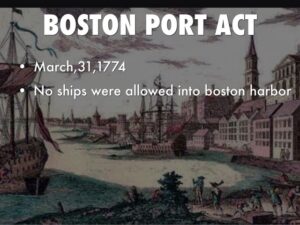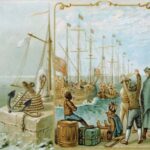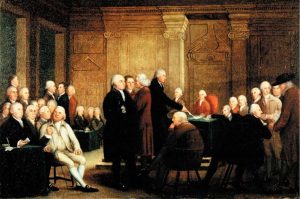american colonies
 After the Boston Tea Party on December 16, 1773, the tensions between the British Parliament and the American Colonies seethed for months. Then, on March 25, 1774, the British Parliament took the next step in its reign of tyranny, when it passed the Boston Port Act. The Boston Port Act closed the port of Boston to all incoming and outgoing ships, while demanding that the city’s residents pay for the nearly $1 million worth (in today’s money) of tea dumped into Boston Harbor during the Boston Tea Party. The act basically held the city under siege, while demanding a ransom for its release.
After the Boston Tea Party on December 16, 1773, the tensions between the British Parliament and the American Colonies seethed for months. Then, on March 25, 1774, the British Parliament took the next step in its reign of tyranny, when it passed the Boston Port Act. The Boston Port Act closed the port of Boston to all incoming and outgoing ships, while demanding that the city’s residents pay for the nearly $1 million worth (in today’s money) of tea dumped into Boston Harbor during the Boston Tea Party. The act basically held the city under siege, while demanding a ransom for its release.
The Boston Port Act was the first and easiest to enforce of the four acts that resulted from the Boston Tea Party. Together, there were four acts, and they were known as the Coercive Acts. The other three were a new Quartering Act, the Administration of Justice Act, and the Massachusetts Government Act. These were passed as part of the Crown’s attempt to intimidate Boston’s increasingly unruly residents. King George III appointed General Thomas Gage, who commanded the British army in North America, as the new governor of Massachusetts in 1774, before the Massachusetts Government Act revoked the colony’s 1691 charter and curtailed the powers of the traditional town meeting and colonial council. Probably the biggest mistake the British made was in not understanding that the main reason the colonists left Britain was to get far enough away from Crown rule to live their own lives. These acts made it very clear to Bostonians that the crown intended to impose martial law, and that was something they just would not stand for.
Gage got right down to business, when in June, he easily sealed the ports of Boston and Charlestown using the formidable British navy. This act left merchants terrified of impending economic disaster. In their panic, many merchants simply wanted to pay for the tea and disband the Boston Committee of Correspondence, which had served to organize anti-British protests. Little did they know that to “bend their knees” to the tyranny would only have served to make matters worse. People make big mistakes when they get in fear. The merchants tried to convince their neighbors to appease the British in the hope of everything just “going away,” but that would never have been the case. A town meeting was called to discuss the matter, and the idea was immediately voted down by a substantial margin.
Parliament hoped that the Coercive Acts would isolate Boston from Massachusetts, Massachusetts from New England, and New England from the rest of North America, thereby preventing unified colonial resistance to the 
 British. Again, they misjudged the colonists, and their effort backfired. Rather than abandon Boston, the colonial population shipped much-needed supplies to Boston and formed extra-legal Provincial Congresses to mobilize resistance to the crown. By the time Gage attempted to enforce the Massachusetts Government Act, his authority had eroded beyond repair. It was another “shot to the heart” of the crown, that would ultimately lead to their complete downfall.
British. Again, they misjudged the colonists, and their effort backfired. Rather than abandon Boston, the colonial population shipped much-needed supplies to Boston and formed extra-legal Provincial Congresses to mobilize resistance to the crown. By the time Gage attempted to enforce the Massachusetts Government Act, his authority had eroded beyond repair. It was another “shot to the heart” of the crown, that would ultimately lead to their complete downfall.

 During the years of growing pains for the United States, it was not considered a nation with any power, or in fact, a nation at all. The British wanted to keep he American Colonies under its power for tax purposes, and for the power that comes when a nation owns large areas of land around the globe. The young country…still under the bonds of British rule, was rebelling against what they considered tyranny, however, they would not get very far without military help coming from somewhere. So, on November 29, 1775, the Second Continental Congress, met in Philadelphia, to establish a Committee of Secret Correspondence. The committee’s goal was to provide European nations with a Patriot interpretation of events in Britain’s North American colonies, in the hope of soliciting aid for the American war effort. The committee consisted of Benjamin Franklin, Benjamin Harrison, John Dickinson, John Hay, and Robert Morris. Following the meeting, the committee instructed Silas Deane to meet with French Foreign Minister Charles Gravier, Count de Vergennes, to stress America’s need for military stores and assure the French that the colonies were moving toward “total separation” from Great Britain. Covert French aid began filtering into the colonies soon after the outbreak of hostilities in 1775, but it was not enough. The Americans had to figure out a way to get more aid.
During the years of growing pains for the United States, it was not considered a nation with any power, or in fact, a nation at all. The British wanted to keep he American Colonies under its power for tax purposes, and for the power that comes when a nation owns large areas of land around the globe. The young country…still under the bonds of British rule, was rebelling against what they considered tyranny, however, they would not get very far without military help coming from somewhere. So, on November 29, 1775, the Second Continental Congress, met in Philadelphia, to establish a Committee of Secret Correspondence. The committee’s goal was to provide European nations with a Patriot interpretation of events in Britain’s North American colonies, in the hope of soliciting aid for the American war effort. The committee consisted of Benjamin Franklin, Benjamin Harrison, John Dickinson, John Hay, and Robert Morris. Following the meeting, the committee instructed Silas Deane to meet with French Foreign Minister Charles Gravier, Count de Vergennes, to stress America’s need for military stores and assure the French that the colonies were moving toward “total separation” from Great Britain. Covert French aid began filtering into the colonies soon after the outbreak of hostilities in 1775, but it was not enough. The Americans had to figure out a way to get more aid.
Deane, a Connecticut delegate to the Continental Congress, left for France on the secret mission on March 3, 1776. He managed to negotiate for unofficial assistance from France, in the form of ships containing military supplies, and recruited Gilbert du Motier, the marquis de Lafayette to share his military expertise with the Continental Army’s officer corps. The aid helped some, but America needed a real commitment from France. That was not so easy to obtain, until after the arrival of the charming Benjamin Franklin in France in December 1776. Then, after the American victory at the Battle of Saratoga in October 1777, the French became convinced that it was worth backing the Americans in a formal treaty. On February 6, 1778, the Treaties of Amity and Commerce and Alliance were signed, and in May 1778 the Continental Congress ratified them.

 One month later, war between Britain and France formally began when a British squadron fired on two French ships. During the American Revolution, French naval fleets proved critical in the defeat of the British, which was assured after the Battle of Yorktown in October 1781. In reality, this was a spy thriller right out of the likes of James Bond, in that every step of this maneuver was critical to the survival of the United States of America, and everything pretty much went exactly as planned.
One month later, war between Britain and France formally began when a British squadron fired on two French ships. During the American Revolution, French naval fleets proved critical in the defeat of the British, which was assured after the Battle of Yorktown in October 1781. In reality, this was a spy thriller right out of the likes of James Bond, in that every step of this maneuver was critical to the survival of the United States of America, and everything pretty much went exactly as planned.

